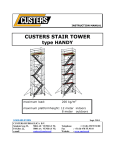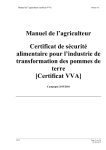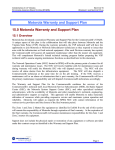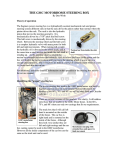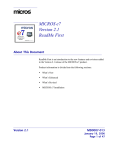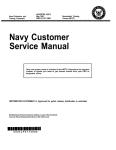Download Additional Annexes for inspection authorities to the User Guide to
Transcript
Additional Annexes for inspection authorities to the User Guide to the food safety certificate for the potato processing industry [VVA Certificate] 2012-2013 cultivation and storage season User Guide to the VVA Certificate Additional annexes Version 10 Introduction An additional annex has been compiled to assist the implementation of the User Guide to the VVA Certificate by the inspection authorities, to ensure that the evaluation criteria are clearly interpreted. See Annex I. There are various levels at which a potato grower can be refused the VVA Certificate. Annex II indicates for each of the evaluation criteria at which level (parcel; variety; crop) a potato grower can be refused a certificate if he fails to implement a measure satisfactorily. During an initial physical audit of the premises, for example, the grower may be given the opportunity to (fully) implement a measure he has not (fully) implemented. This can also be done by producing written evidence to this effect within a deadline agreed with the inspection authority. Where possible, administrative errors should be rectified on the spot, with the grower showing documentary evidence to the inspector. A specific physical audit must subsequently be carried out on 10% of these growers, in order to check that the measures have now been implemented. If it appears that the measure in question has still not been implemented, then the VVA Certificate will immediately be withdrawn. Report of audit data The inspection authority must submit the audit data in Dutch to the buyers in accordance with the report file format on www.vavi.nl. The inspection agency is obliged to ensure that the growers’ database is available digitally. Notifying growers of changes The inspection authority is obliged to notify any changes in the VVA certificate (e.g. following annual reviews) to all growers, including the interpretation of the evaluation criteria. Changes to the inspection authority The inspection authority must notify any changes it has made regarding its own data (e.g. address details, names of contacts) to VAVI. The updated details for the inspection authorities can be found on www.vavi.nl. Residue analysis Leaf samples for residue analysis must be taken from the middle of the parcel. The results of residue analyses must be known to the buyer before delivery. Certification details During the audit of the premises the inspection authorities should agree with the grower in which name(s) the certificate is to be issued so that several VVA certificates do not need to be written for the same address. The certificate is valid for 1 year. The period of validity should be mentioned on the certificate. This expiry date should be communicated to the buyer. The next company audit must be scheduled to take place within 15 months of the certification date. VAVI Page 2 of 14 01-03-2012 User Guide to the VVA Certificate Additional annexes Version 10 ANNEX I: Interpretation of the evaluation criteria for the VVA Certificate GENERAL REMARKS Evaluation criteria for the VVA Certificate & Interpretation 1. Complete the self-assessment checklist annually prior to company audit (date and signature). Must be present and fully completed during audit, or inspection will be suspended. Grower will be warned of this when inspection authority makes appointment to conduct an audit. 2. Use properly maintained and clean machinery during cultivation, harvesting, transport, storage and delivery. This machinery should not show any leaks and/or loose (glass) elements. If there is direct contact between machinery oil and the product, then use food grade oil. Check for breaks on mirrors, windows and lights, patches of oil under machinery, lumps of grease, and damage to conveyor belts. Substances that are not part of the product (worn components, rubber, grease, oil, glass) may not be allowed to enter the (harvested) product. 3. The use of machinery which, in the growing season, has been in contact with GMC potatoes during harvesting, transport, storage and delivery is not permitted. 4. Clear registration of the identity of the parcel (register the location of the parcel). Clearly indicate which parcels qualify for a ‘VVA Certificate’. Check how the location of the parcel is registered, e.g. sketch showing the variety and surface area, name of parcel or code and whether this corresponds with the registration of the composting and crop protection agents. If more than one variety is being grown, the separation of the varieties must be visually discernible. 5. Register the identity of parcels / batches during storage (label, floor plan of the storage space, code). 6. All the registrations of cultivation and storage, audit reports and certificates required for the audit of the VVA Certificate must be kept for at least 3 years. Administrative audit. This is not retrospectively applicable during the first inspection, but registrations going back at least 3 months must be available at that time. 7. Do not add (parts of) batches that do not meet ‘VVA Certificate’ criteria; keep these separate. Clear division between the batches that do and do not meet VVA criteria. 8. Grower is responsible for, and must oversee, the loading of the correct parcel / batch. Undertaking by grower; check of loading declaration (sign off for clean trailer) if possible. 9. If a parcel / batch is switched, remove all the tubers from the warehousing / exwarehousing equipment (conveyor belts, etc.). Check whether equipment is clean and free of old tubers. 10. Registration of batches supplied (date, buyer). Registration (by keeping consignment notes or invoices), both ex-land and storage cells. VAVI Interpretation 1. Administrative audit 2. Visual inspection* 3. Undertaking by grower: Visual inspection 4. Visual inspection* 5. Visual inspection* 6. Administrative audit* 7. Visual inspection 8. Visual inspection: Undertaking by grower 9. Visual inspection: Undertaking by grower 10. Administrative audit Page 3 of 14 01-03-2012 User Guide to the VVA Certificate Additional annexes Version 10 11. Keeping purchase records and/or invoices for seed potatoes, crop protection agents, fertilisers and biocides. Checking whether purchase chits and/or invoices are present in accounts. Seed potatoes must be in grower’s own name. 12. Mandatory registration of accidents or mishaps; send registration and notify the buyer in the event of fire, accidents or detection of foreign bodies (such as) glass, oil, crop protection agents, quarantined crops, other harmful foreign bodies and/or GMC, including registration of what corrective measure(s) have been taken. Immediate supply of information about the batch to buyer following a request to this effect. Moreover, in the event of detecting harmful or unfit products, the accident/mishap should be reported to the VWA. Please see the VWA reporting indicator at www.vwa.nl. Growers are responsible for this. On the basis of your administration, you should be able (after verbal contact) to give information within 4 hours on the origin of a batch, or part of a batch, supplied and on any other parts of the original batch (to whom supplied, date, quantity). If a batch is sold as animal feed, the accident/mishap must also be reported to the Product Board Animal Feed (PDV). Foreign growers should report any accidents/mishaps to the local competent authorities. Check registration of accidents and mishaps and ascertain what is understood by them. 13. If work is outsourced to contractors or subcontractors (grower must have a copy of this), they must - hold a certificate (VKL/VBL), or - be in possession of a food safety certificate for potatoes (VVA) or GLOBALGAP, or - have been audited by an inspection authority as part of the VVA audit. Ask whether contractors are being used, check available certificates (www.vkl.nl or copy of certificate), or else audit contractor. 11. Administrative audit 12. Visual inspection Registration of accidents or mishaps 13. Administrative audit or audit of contractor *If, after the first physical company audit, there are measures that have not (fully) been implemented and there is no long-term risk to food safety, then the potato grower may be given the opportunity to (fully) implement a measure that he has not previously (fully) implemented. CULTIVATION Evaluation criteria for the VVA Certificate & Interpretation 14. Cultivation is only permitted on parcels that have not been contaminated by unauthorised substances in the past 3 years. (e.g. polluted silt, glass oil, dioxins, heavy metals) or from when the cultivated earth has been chemically polluted by past cultivation or activities (e.g. fruit tree cultivation, dumping, industrial site). Mandatory removal of contamination (glass shards, plastic, etc., especially along public roads). If in doubt: analyse the soil. Ask about the historical risks of the parcel: non-agricultural uses to which it has been put, (trial) fields with GMCs or unauthorised crop protection agents. How are the risks of the parcel’s location being dealt with: waste from adjacent bicycle paths/roads, industrial estates. 15. Thorn apple (Datura stramontium) must be removed from the parcel by hand. See illustration. 16. No cultivation permitted within a range of at least 10 metres from GMC potato trial fields. Trial fields are generally known. All the GMC trial fields from 1998 to the present in NL, D, Fr and/or B are known to the inspection authority and are registered on VAVI Interpretation 14. Undertaking by grower* 15. Undertaking by grower 16. Undertaking by grower Page 4 of 14 01-03-2012 User Guide to the VVA Certificate Additional annexes Version 10 a list. 17. No cultivation permitted on parcels where GMC potatoes have been grown in the last 4 years. Idem see 2. 18. Only use officially approved propagating material. An official inspection certificate has to be available for each batch and an invoice or delivery note showing the scope and identity. This does not apply if the buyer ensures there is approved base material. When own propagation is carried out, a proof of approval has to be available in accordance with national legislation. Check NAK labels, official labels on foreign seed potatoes, proof of purchase. 19. Cultivation of GMC varieties is not permitted. Check variety. 20. Follow fertilisation recommendations (preferably using analysis figures) to prevent pollution. Compare results of analysis and recommendations with the registration or with the composting plan, or substantiated verbal composting strategy and show actions taken (cultivation registration). 21. Use only soil improvers with a (product) certificate or analysis report which shows that the product satisfies the Fertilisers Act and is almost totally free of contamination by glass. Green/ and biodegradable waste / compost has to be certified in accordance with “Keurcompost” (Certified Compost) the quality mark pertaining to the sector, unless the above analytical covers up to 1.000 tonnes of fresh compost and compliance with the glass standard. Acceptable glass content: no more than 0.2% (m/m), on dry material, with a minimum particle size of 2 mm and a maximum particle size of 20 mm. 22. Do not use sewage sludge for organic fertiliser. 23. Store fertilisers in accordance with national and local legislation. Visual inspection of storage. 24. Store fertilisers away from crop protection agents. Visual inspection of storage. 25. Only use statutorily approved fertilisers. 26. Use correctly-adjusted , clean and properly-functioning spreader. Calibration (audit of function, settings and distribution) must be carried out annually, with the date of the audit recorded (calibration can be performed by the grower himself or by an external contractor). Date of registration in self-assessment checklist. 27. Keep up-to-date records (at least 1 x per week). Check updated registration. 28. The technical supervisor (grower and/or cultivation supervisors) for crop protection and fertilisation must be able to demonstrate his competence (e.g. by a sprayer licence) and to substantiate the use of crop protection agents (e.g. by a sprayer licence). A sprayer licence (for the Netherlands) is mandatory. Where it is not mandatory, technical supervisor must show evidence of the necessary experience. Demonstrable training/instruction received and/or experience, curriculum vitae of cultivation supervisor if he is technical supervisor. VAVI 17. Undertaking by grower 18. Seed potato certificate 19. Seed potato certificate 20. Analysis figures / composting strategy cultivation registration* 21. Product certificate for soil improvers, check on parcel* Certificate Compost 22. Undertaking by grower 23. Visual inspection of storage* 24. Visual inspection of storage 25. Check registration; (sampling soil and/or crop) 26. Visual inspection of machinery*; Crop check 27. Check registration* 28. Administrative audit; sprayer licence Page 5 of 14 01-03-2012 User Guide to the VVA Certificate Additional annexes Version 10 29. Store crop protection agents in accordance with national and local legislation. Visual inspection of storage facility. 30. Use correctly-adjusted , clean and properly-functioning sprayer. Follow the statutory inspection intervals (test certificate present). In countries without mandatory inspection, annual calibration must be carried out (date recorded). Valid test certificate or sticker, sprayer licence available, visual check, clean. Date registration calibration in self-assessment checklist. 31. Maximum dosage and the number of applications in line with user instructions must not be exceeded. Check registration, compare with DLV guide for relevant year (and/or other recent list in country where check is taking place); if necessary, check on label. Low dosage system can be applied. 32. Only use statutorily approved agents. Check registration with CTB list for relevant year (and/or other recent list in country where check is being carried out). 33. Comply with safety periods. Check registration with CTB data for relevant year (and/or other recent list in country where check is being carried out) and date of first harvest. 34. Keep up-to-date records of crop protection agents used (including notifying harvesting date in connection with waiting times), reason for use, name of user and type of treatment (1 x per week). Check updated registration. Reason for use = fungicides, herbicides, insecticides. Type of treatment= full-field, back spray, etc. 35. Hunting prohibited if there is a risk of shot entering product. Ask how hunting is organised (lease basis). Undertaking by grower. 36. Only use good quality rainwater / sprayer water. If in doubt, consult analysis report. Ask how quality of rainwater is maintained. 29. Visual inspection of storage facility 30. Test certificate; visual inspection; sprayer licence, where applicable 31. Administrative audit; check registration 32. Check registration (sampling of tubers and/or crop) 33. Check registration (sampling of tubers and/or crop) 34. Check registration* 35. Undertaking by grower 36. Undertaking by grower; Analysis report; visual inspection HARVESTING / WAREHOUSING Evaluation criteria for the VVA Certificate & Interpretation 37. Mandatory sailcloth over trailer and warehousing equipment if rain is expected. Sailcloths present or dry warehousing. Grower can undertake not to warehouse crop if rain is expected. 38. No foreign bodies in means of transport (use clean trailers, boxes, etc.). Check for clean trailers and boxes. 39. No broken transport/storage facilities (boxes, etc.). Check for damaged or splintered wood. No broken boxes permitted. VAVI Interpretation 37. Visual inspection* Undertaking by grower 38. Visual inspection during harvest* 39. Visual inspection during harvest and storage Page 6 of 14 01-03-2012 User Guide to the VVA Certificate Additional annexes Version 10 STORAGE / WAREHOUSING Evaluation criteria for the VVA Certificate& Interpretation 40. Storage only in clean storage facilities (year-round clean storage facilities free of contamination). Visual check. Storage of materials in “unused” storage space is permitted only if there is no risk of contamination (under no circumstances fertilisers, biologically degradable packaging or machinery with oil or chemical leaks). 41. Storage facilities must be in a good state of repair (no broken planks, insulation material, etc.). No splintered wood (planed planks not obligatory), no loose materials (including from room above storage space), ceiling of undamaged asbestos tiles is permitted (must be replaced only by recognised firm and not during storage of potatoes). 42. Storage facilities must be clearly separated from machinery storage/workplace. Check for clear physical separation. 43. Pets and other animals may not come into contact with/settle on the product in the storage facilities. No evidence of animals and/or faeces on product. 44. Prevent the faeces of pets and other animals and birds from coming into contact with product, e.g. by applying mesh or netting to intake and outlet flaps. Wire mesh over intake and outlet flaps; if no mesh always close flaps when no ventilation taking place. 45. No storage in storage facilities/boxes where GMC potatoes have been stored during the same growing season. 46. Never store crop protection agents or fertilisers in the storage facilities. Check that crop protection agents are in cupboard only and cleaned packaging is never in storage area. 47. Waste (e.g. packaging materials, remains) and hazardous substances should be stored in such a way as to prevent contamination of the product. 48. Mandatory steps to combat vermin (e.g. boxes or traps) in and around the storage facilities. Prevent anti-pest agents from coming into contact with the product. Check presence of traps (outside). Loose mouse or rat poison must only be used outside storage area and may not be able to enter the product. The use of cats to destroy vermin only permitted outside storage area. 49. Administer in accordance with statutory dosage regulations, instructions and other guidelines on the sprout inhibitor agent label. In relation to the use of shoot inhibitors, the technical person responsible (grower and/or cultivation supervisors) has to be able to demonstrate his competence (by means of, for example, a spraying licence) and substantiate the use of shoot inhibitors (by means of, for example, a spraying licence). A spraying licence (in the Netherlands) is compulsory, if not compulsory, the technically responsible person has to demonstrate his experience. Check registration, compare with DLV guide (as 31) or recent list in country where audit is taking place), or check on label if necessary. 50. Keep up-to-date records of sprout inhibitors used. Check updated registration. 51. Try to maintain optimum climate control (maintain correct water temperature in air humidifiers). No rotting or decomposition odours (otherwise register as mishap). 52. Only use correctly-adjusted, properly-installed and well-maintained heating equipment (do not place on or over product). VAVI Interpretation 40. Visual inspection 41. Visual inspection* Repairable in growing season 42. Visual inspection 43. Visual inspection 44. Visual inspection Undertaking by grower* 45. Undertaking by grower 46. Visual inspection 47. Visual inspection 48. Visual inspection* 49. Check registration (sampling of tubers) 50. Check registration* 51. Visual inspection* 52. Visual inspection* Page 7 of 14 01-03-2012 User Guide to the VVA Certificate Additional annexes Version 10 53. Only use fuels that are suitable for drying/heating products. 54. Ensure presence of a protective plate, shatterproof lamps or a protective sheath where potatoes are being processed or stored. Visual check, ask for report if in doubt that lamps are shatterproof. 55. Use of mercury and/or glass thermometer in or above the potatoes is prohibited. Visual check, no damaged thermometer glass permitted. Glass thermometers should preferably be covered with plastic tape so that if they are broken, no glass can enter product. 56. No direct daylight in storage facilities above product. 57. Well-maintained cooling equipment, only with cover plate over product (STEK test certificate). Applicable with mechanical cooling equipment. Visual check, STEK logbook test certificate to hand. VAVI 53. Visual inspection 54. Visual inspection during storage 55. Visual inspection during storage 56. Visual inspection during storage 57. Visual inspection* Page 8 of 14 01-03-2012 User Guide to the VVA Certificate Additional annexes Version 10 EX-WAREHOUSING / DELIVERY Evaluation criteria for the VVA Certificate & Interpretation Interpretation 58. Deploy sufficient capacity to weed out foreign substances / green tubers during delivery. Undertaking by grower or check during loading. 59. Strictly comply with safety periods (waiting times) when using chemicals. Check for first possible delivery date. Safety period set down in registration. 60. In the event of transport under own management: clean vehicle after transporting the following: 58. Visual inspection; Undertaking by grower 59. Administrative audit* 60. Visual inspection; Undertaking by grower A. B. C. D. E. F. animal feed inputs: sweep out; soil/stones: clean with water (high pressure); artificial fertiliser: clean with water; packaged products: sweep out; dry stackable poultry and horse manure: clean and disinfect; wet fertiliser: clean, disinfect and release after external checks carried out by an ISO 17020-certified inspection authority. 61. In the event of transport by third parties at grower’s request: Transporter must hold a GMP B4.1 transport certificate and must be able to show that he meets the necessary requirements (copy of certificate). Demonstrably accredited via copy of GMP B4.1 certificate or www.pdv.nl, except for transport at buyer’s request. VAVI 61. Administrative audit Page 9 of 14 01-03-2012 User Guide to the VVA Certificate Additional annexes Version 10 ANNEX II: Level of refusal GENERAL REMARKS Evaluation criteria for the VVA Certificate Level of refusal 1. Complete self-assessment checklist annually prior to company audit (date and signature). 2. Use properly maintained and clean machinery during cultivation, harvesting, transport, storage and delivery. This machinery should not show any leaks and/or loose (glass) elements. If there is direct contact between machinery oil and the product, then use food grade oil. 3. The use of machinery which, in the growing season, has been in contact with GMC potatoes during harvesting, transport, storage and delivery is not permitted. 4. Clear registration of the identity of the parcel (register the location of the parcel) Clearly indicate which parcels qualify for a ‘VVA Certificate’. 5. Register identity of parcels/batches during storage (label, floor plan of storage area, code). 6. All the registrations of cultivation and storage, audit reports and certificates required for the audit of the VVA Certificate must be kept for at least 3 years. 7. Do not add (parts of) batches that do not meet ‘VVA Certificate’ criteria; keep these separate. 8. Grower is responsible for, and must oversee, the loading of the correct parcel / batch. 9. If a parcel / batch is switched, remove all the tubers from the warehousing / exwarehousing equipment (conveyor belts, etc.). 10. Registration of batches supplied (date, buyer). 11. Keeping purchase records and/or invoices for seed potatoes, crop protection agents, fertilisers and biocides. 12. Mandatory registration of accidents or mishaps; send registration and notify the buyer in the event of fire, accidents or detection of foreign bodies (such as) glass, oil, crop protection agents, quarantined crops, other harmful foreign bodies and/or GMC, including registration of what corrective measure(s) have been taken. Immediate supply of information about the batch to buyer following a request to this effect. Moreover, in the event of detecting harmful or unfit products, the accident/mishap should be reported to the VWA. Please see the VWA reporting indicator at www.vwa.nl. Growers are responsible for this. On the basis of your administration, you should be able (after verbal contact) to give information within 4 hours on the origin of a batch, or part of a batch, supplied and on any other parts of the original batch (to whom supplied, date, quantity). If a batch is sold as animal feed, the accident/mishap must also be reported to the Product Board Animal Feed (PDV). Foreign growers should report any accidents/mishaps to the local competent authorities. 1. Crop 13. If work is outsourced to contractors or subcontractors (grower must have a copy of this), they must - hold a certificate (VKL/VBL), or - be in possession of a food safety certificate for potatoes (VVA) or GLOBALGAP, or - have been audited by an inspection authority as part of the VVA audit. 13. Crop VAVI 2. Crop* 3. Crop 4. Parcel* 5. Variety* 6. Crop* 7. Variety 8. Variety 9. Variety 10. Variety 11. Variety 12. Crop Page 10 of 14 01-03-2012 User Guide to the VVA Certificate Additional annexes Version 10 *If, after the first physical company audit, there are measures that have not (fully) been implemented and there is no long-term risk to food safety, then the potato grower may be given the opportunity to (fully) implement a measure that he has not previously (fully) implemented. CULTIVATION Evaluation criteria for the VVA Certificate Level of refusal 14. Cultivation is only permitted on parcels that have not been contaminated by unauthorised substances in the past 3 years. (e.g. polluted silt, glass oil, dioxins, heavy metals) or from when the cultivated earth has been chemically polluted by past cultivation or activities (e.g. fruit tree cultivation, dumping, industrial site). Mandatory removal of contamination (glass shards, plastic, etc., especially along public roads). If in doubt, analyse the soil. 15. Thorn apple (Datura stramontium) must be removed from the parcel by hand. 16. No cultivation permitted within a range of at least 10 metres from GMC potato trial fields. 17. No cultivation permitted on parcels where GMC potatoes have been grown in the last 4 years. 18. Only use officially approved propagating material. An official inspection certificate has to be available for each batch and an invoice or delivery note showing the scope and identity. This does not apply if the buyer ensures there is approved base material. When own propagation is carried out, a proof of approval has to be available in accordance with national legislation. 19. Cultivation of GMC varieties is not permitted. 20. Follow fertilisation recommendations (preferably using analysis figures) to prevent pollution. 21. Use only soil improvers with a (product) certificate or analysis report which shows that the product satisfies the Fertilisers Act and is almost totally free of contamination by glass. Green/ and biodegradable waste / compost has to be certified in accordance with “Keurcompost” (Certified Compost) the quality mark pertaining to the sector, unless the above analytical covers up to 1.000 tonnes of fresh compost and compliance with the glass standard. Acceptable glass content: no more than 0.2% (m/m), on dry material, with a minimum particle size of 2 mm and a maximum particle size of 20 mm. 22. Do not use sewage sludge for organic fertiliser. 23. Store fertilisers in accordance with national and local legislation. 24. Store fertilisers away from crop protection agents. 25. Only use statutorily approved fertilisers. 26. Use correctly-adjusted , clean and properly-functioning spreader. Calibration (audit of function, settings and distribution) must be carried out annually, with the date of the audit recorded (calibration can be performed by the grower himself or by an external contractor). 27. Keep up-to-date records (at least 1 x week). 28. The technical supervisor (grower and/or cultivation supervisors) for crop protection and fertilisation must be able to demonstrate his competence (e.g. by a sprayer licence) and to substantiate the use of crop protection agents (e.g. by a sprayer licence). A sprayer licence (for the Netherlands) is mandatory. Where it is not mandatory, technical supervisor must show evidence of the necessary VAVI 14. Parcel* 15. Parcel 16. Parcel 17. Parcel 18. Variety 19. Crop 20. Crop* 21. Parcel* 22. Parcel 23. Crop* 24. Crop 25. Crop 26. Crop* 27. Parcel* 28. Crop Page 11 of 14 01-03-2012 User Guide to the VVA Certificate Additional annexes Version 10 experience. 29. Store crop protection agents in accordance with national and local legislation. 30. Use correctly-adjusted, clean and properly-functioning sprayer. Follow the statutory inspection intervals (test certificate present). In countries without mandatory inspection, annual calibration must be carried out (date recorded). 31. Maximum dosage and the number of applications in line with user instructions must not be exceeded. 32. Only use statutorily approved agents. 33. Comply with the safety periods. 34. Keep up-to-date records of crop protection agents used (including notifying harvesting date in connection with waiting times), reason for use, name of user and type of treatment (1 x week). 35. Hunting prohibited if there is a risk of shot entering product. 36. Only use good quality rainwater / sprayer water. If in doubt (surface water, sewage overflow), consult analysis report. 29. Crop 30. Crop 31. Parcel 32. Crop 33. Parcel 34. Parcel* 35. Parcel 36. Crop HARVESTING / WAREHOUSING Evaluation criteria for the VVA Certificate 37. Mandatory sailcloth over trailer and warehousing equipment if rain is expected. Sailcloths present or dry warehousing. Grower can undertake not to warehouse crop if rain is expected. 38. No foreign bodies in means of transport (use clean trailers, boxes, etc.). Check for clean trailers and crates. 39. No broken transport/storage facilities (boxes, etc.). Check for damaged or splintered wood. No broken boxes permitted. VAVI Level of refusal 37. Crop* 38. Crop* 39. Crop Page 12 of 14 01-03-2012 User Guide to the VVA Certificate Additional annexes Version 10 STORAGE / WAREHOUSING Evaluation criteria for the VVA Certificate & Interpretation 40. Storage only in clean storage facilities (year-round clean storage facilities free of contamination). 41. Storage facilities must be in a good state of repair (no broken planks, insulation material, etc.). 42. Storage facilities must be clearly separated from machinery storage/workplace. 43. Pets and other animals may not come into contact with/settle on the product in the storage facilities. 44. Prevent the faeces of pets and other animals and birds from coming into contact with product, e.g. by applying mesh or netting to intake and outlet flaps. 45. No storage in storage facilities/boxes where GMC potatoes have been stored during the same growing season. 46. Never store crop protection agents or fertilisers in the storage facilities. 47. Waste (e.g. packaging materials, remains) and hazardous substances should be stored in such a way as to prevent contamination of the product. 48. Mandatory steps to combat vermin (e.g. boxes or traps) in and around the storage facilities. 49. Administer in accordance with statutory dosage regulations, instructions and other guidelines on the sprout inhibitor agent label. 50. Keep up-to-date records of sprout inhibitors used. 51. Try to maintain optimum climate control (maintain correct water temperature in air humidifiers). 52. Only use correctly-adjusted, properly-installed and well-maintained heating equipment (do not place on or over product). 53. Only use fuels that are suitable for drying/heating products. 54. Ensure presence of a protective plate, shatterproof lamps or a protective sheath where potatoes are being processed or stored. 55. Use of mercury and/or glass thermometer in or above the potatoes is prohibited. 56. No direct daylight in storage facilities above product. 57. Well-maintained cooling equipment, only with cover plate over product (STEK test certificate). VAVI Level of refusal 40. Variety 41. Variety* 42. Variety 43. Variety 44. Variety* 45. Crop 46. Crop 47. Crop 48. Variety* 49. Variety 50. Variety* 51. Variety* 52. Variety* 53. Variety 54. Variety 55. Variety 56. Variety 57. Variety* Page 13 of 14 01-03-2012 User Guide to the VVA Certificate Additional annexes Version 10 EX-WAREHOUSING / DELIVERY Evaluation criteria for the VVA Certificate Level of refusal 58. Deploy sufficient capacity to weed out foreign substances / green tubers during delivery. 59. Strictly comply with safety periods (waiting times) when using chemicals. 60. In the event of transport under own management: clean vehicle after transporting the following: 58. Variety 59. Variety* 60. Crop A. B. C. D. E. F. animal feed inputs: sweep out; soil/stones: clean with water (high pressure); artificial fertiliser: clean with water; packaged products: sweep out; dry stackable poultry and horse manure: clean and disinfect; wet fertiliser: clean, disinfect and release after external checks carried out by an ISO 17020-certified inspection authority. 61. In the event of transport by third parties at grower’s request: Transporter must 61. Crop hold a GMP B4.1 transport certificate and must be able to show that he meets the necessary requirements (copy of certificate). VAVI Page 14 of 14 01-03-2012















